What is Deck Plate
A faucet deck plate is a small but essential kitchen sink component. It covers the hole in the countertop where the faucet is mounted, and it helps to protect the finish on your countertop.
A faucet deck plate is a flat piece of metal or plastic that covers the hole in a sink where the faucet is installed. It may also be called a base plate, escutcheon, or flange. The deck plate serves two purposes: to cover the unsightly plumbing beneath the sink and to provide a stable surface for mounting the faucet.
A faucet deck plate is a flat piece of metal or plastic that covers the hole in a sink where the faucet is installed. It may also be called a base plate, escutcheon, or flange. The deck plate serves two purposes-
- To cover the unsightly plumbing beneath the sink and
- To provide a stable surface for mounting the faucet.
A faucet deck plate is a decorative or protective cover for the escutcheon, which is the part of the faucet that covers the hole in the sink. The deck plate can be used to cover up an unsightly escutcheon, or it can be used to protect the escutcheon from damage
Most deck plates are round or oval-shaped and have one or more holes drilled into them to accommodate the water supply lines and drain pipe.
Three most popular deck plates
What is the Purpose of a Deck Plate for a Faucet?
A deck plate is a metal or plastic cover that mounts over the escutcheon, the round metal plate that surrounds the faucet handle on a sink. The deck plate covers any holes in the sink that are not being used by the faucet, giving the sink a more finished look. In some cases, the deck plate also serves as a decorative element, adding to the sink’s overall design.
Faucet With Or Without Deck Plate
If you’re wondering whether or not to get a faucet with a deck plate, there are a few things to consider. First, what is your budget? If you have a limited budget, you may opt for a faucet without a deck plate.
Deck or cover plates can add an extra level of sophistication to your kitchen but also come at a higher price tag. Second, what is the style of your kitchen? A deck plate might be the way to go if you have a more traditional kitchen.
However, if your kitchen has more of a contemporary feel, then you might want to stick with a faucet without one. Third, how easy is it to install? Deck plates can sometimes be tricky to install, so if you’re not confident in your DIY skills, it might be best to leave this task to the professionals.
Ultimately, whether or not to get a faucet with a deck plate comes down to personal preference and budget.
Is a Faucet Deck Plate Necessary?
In most cases, a deck plate is not necessary for kitchen and bathroom faucets. You can mount the kitchen faucet without using a deck plate. However, a deck plate can cover the unused holes if your faucet has multiple handles. The result will be a cleaner feeling in the kitchen and bathroom sink. Additionally, if you have a single-hole faucet, a deck plate can be used to make it compatible with a three-hole sink.
A faucet deck plate is a great way to add style and function to your kitchen. This type of plate comes in many different styles, so you can find one that fits your decor perfectly. For example, you can use this plate to protect your countertop from water damage, or you can use it to create a new look for your kitchen.
One of the most popular uses for a faucet deck plate is to protect your countertop from water damage. However, if you have ever had water damage to your countertop, then you know how expensive it can be to repair.
A deck plate can help prevent this damage by creating a barrier between the water and the countertop. You can also use this plate To cover up any scratches or stains on your countertop. This is a great way to keep your kitchen looking its best.
Another widespread use for a faucet deck Plate is creating a new look for Your Kitchen. If you want to change the style of your kitchen but don’t want To spend a lot of money, then replacing the fixture can be a great way to do it. Many different styles of these plates are available, so you should have no problem finding one that matches the decor of your kitchen.
Uses of Faucet Deck Plates
Various types of faucet deck plates are available. In precise, different kinds of faucets needs different types of deck plates. There probably is a perfect faucet deck plate for every sink, depending on its function and style.
In the widespread faucet, in most cases, there is no need to use a deck plate. Instead, the sink is equipped with multiple holes for mounting it. For example, in a widespread faucet, three pieces are fixed eight inches apart in the sink.
Almost all of the centerset faucet has a deck plate. It is used to set up the kitchen sink for mounting the faucet. You have to use the deck plate to change the widespread kitchen faucet into a centerset kitchen faucet. The reason is to close the holes of the widespread faucet.
Type of Faucets Deck Plates
There are several different types of faucet deck plates. The most common type is the single-hole plate, which covers a single hole in the countertop. There are also double-hole plates, used to cover two holes, and triple-hole plates, used to cover three holes.
Deck plates can be made from various materials, including plastic, metal, and composite. Several different types of faucet deck plates are available, and each has its advantages and disadvantages.
Metal Deck Plate
The most common type of faucet deck plate is made of metal. Metal deck plates are very durable and will last for many years. However, they can be challenging to clean and may show fingerprints and water spots more quickly than other deck plates.
Plastic Deck Plate
Plastic deck plates are another popular option. They are usually less expensive than metal deck plates and easier to clean. However, plastic deck plates can scratch easily and may not be as durable as metal ones.
Composite Deck Plate
Composite deck plates are made from a combination of materials, including plastic and metal. Composite deck plates are more resistant to scratches than plastic ones, but sharp objects can still scratch them. Composite deck plates are also more expensive than either metal or plastic options.
How to Install a Faucet Deck Plate
If your faucet has one handle, it is most likely a deck plate model. Deck plate models have a single hole in the sink or countertop for the faucet handle and a second hole covered by the deck plate. The deck plate covers this second hole when the faucet is not used and gives the sink or countertop a more finished look.
Installing a deck plate is relatively easy and only takes a few minutes. Start by turning off the water in your sink. There should be two shut-off valves under your sink, one for hot water and one for cold water.
Turn each valve clockwise to turn off the water flow. Next, remove any existing hardware from your sink or countertop, including any escutcheons or small plates. If screws are holding down the old hardware, use a screwdriver to remove them.
Once everything is removed, you should see two holes in your sink or countertop – one for the faucet handle and one for the spout. Now it’s time to install your new deck plate. First, place it over the second hole (the one for the spout) and align it with the hole using its built-in template (most deck plates will have some template).
Once you have it aligned properly, use screws to secure it in place (if required). Again, be sure not to overtighten, as this could strip out the threads in your sink/countertop material. Finally, reattach your faucet handle (and any other hardware) using its supplied mounting nuts/screws – again, be careful not to overtighten these so as not to damage anything internally.
Once everything is tightened down properly, turn on both shut-off valves slowly until water begins flowing through your faucet again!
How to Install Kitchen Faucet Without Deck Plate
Installing a kitchen faucet without a deck plate might sound daunting, but it’s pretty simple! Here’s what you’ll need to do:
- Turn off the water supply to your kitchen sink. This is usually done by shutting off the valves under the sink.
- Disconnect the supply lines from the old faucet. You’ll likely need a wrench to loosen the nuts that secure the lines to the faucet.
- Remove the old faucet by unscrewing it from the mounting holes in the sink. Be careful not to damage your sink while doing this!
- Inspect your new faucet for any damage and ensure all parts are accounted for before proceeding with the installation.
- Install your new faucet according to manufacturer instructions, being careful not to overtighten any screws or connections. You may need someone to help you hold it in place while you attach it properly. Make sure there are no leaks before moving on!
Faucet Deck Plate Sizes
When it comes to faucets, there is no one-size-fits-all. Faucet deck plates come in various sizes to accommodate different sink configurations. The most crucial factor to consider when selecting a deck plate is the size of your sink’s hole configuration.
Depending on the number and size of holes in your sink, you will need to select a corresponding deck plate. The most common sinkhole configurations are 4″, 6″, 8″, 10″ & 12″. The 4″ sinks typically have one large hole for the faucet and two smaller holes for the handles. 6″ sinks usually have three holes – one for the faucet and two for the handles. 8″ sinks typically have four holes – two for the faucet and two for the handles.
You may need a custom deck plate if your sink has a different configuration. Once you know the size of your sink’s hole configuration, you can select a deck plate that will fit snugly over it. Be sure to measure carefully before making your purchase!
3-Hole Faucet Deck Plate
3-hole faucet deck plates are used to cover the unused holes on a sink or countertop. They come in a variety of sizes and finishes to match your fixtures. Deck plates also provide convenient access to the plumbing beneath your sink.
Do you have to use the deck plate when installing a faucet?
No, you don’t have to use a faucet deck if you want to install a faucet yourself. However, we recommend using one because it makes changing out your faucet much more straightforward. Plus, it adds stability to the sink so that it doesn’t move while you’re working underneath it.
Can I Replace My Old Faucet Deck With Newer Models?
Yes, you can replace your old faucet deck with newer models. Just make sure that the new model has the same number of holes as the original faucet deck. For example, if your old faucet had two holes, then you should get a new faucet deck with two holes.
Conclusion
A faucet deck plate is a flat piece of metal or plastic that covers the hole in a sink where the faucet is installed. Deck plates are available in various sizes and styles to match any sink and faucet combination.

As the chief content writer, Hassan Al Sarker works as a professional kitchen-based content creator at Kitchen Liker.
In addition to reviewing the content published on Kitchen Liker, he ensures that it is accurate, relevant, and helpful. As a result, all the reviews and information published at Kitchen Liker are neutral and userfriendly.
Hassan Al Sarker has a bachelor’s degree in Hotel and Tourism Management From the Newyork University. Before joining Kitchen Liker, he was a contributor at Kitchen Club, United States.




